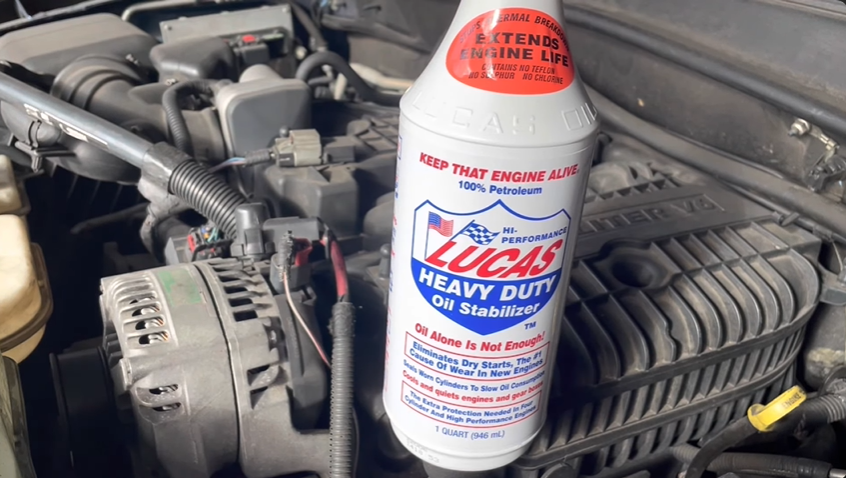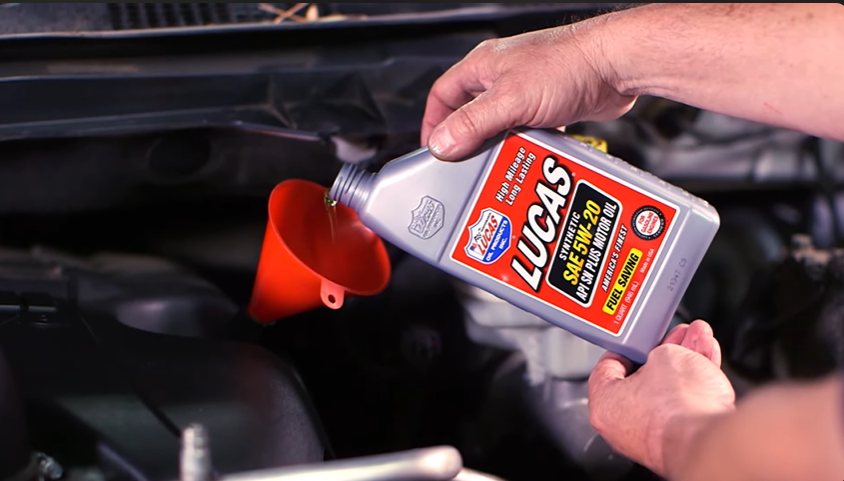Before checking the oil level, the car should be turned off and given a few minutes to cool so that the oil has had time to settle. The dipstick is usually located near the front of the engine on the side and has a yellow or orange loop at one end. To check the oil, pull out the dipstick and wipe it clean with a rag.
Insert it back in and then remove it again to check the level. There should be enough oil to reach between the “low” and “full” marks on the dipstick. If it’s below this range, then more oil will need to be added.
- Start the engine and let it warm up for a few minutes before checking the oil level
- Pull out the dipstick and wipe it clean with a rag or paper towel
- Insert the dipstick back into the engine, then pull it out again to check the oil level
- The oil should be between the “full” and “low” marks on the dipstick
- If it’s below the “low” mark, you’ll need to add more oil

What Do the Lines on Oil Dipstick Mean?
When you check your oil level, the dipstick will have two lines. The top line is the “full” line, and the bottom line is the “add” or “low” line. The space between these two lines is where your oil level should fall.
If it’s below the “add” or “low” line, then you need to add more oil. If it’s above the full line, then you have too much oil in your engine, and you should drain some out.
What is the Normal Oil Level on a Dipstick?
Most carmakers recommend that you check your engine oil level at least once a month and more often if you drive frequently or put a lot of miles on your car in a short period. Checking your oil level is easy and only takes a few minutes. To check your oil level, find the dipstick under the hood (usually it has a bright yellow handle), pull it out, and wipe it off with a clean rag.
Insert the dipstick back into its tube, then pull it out again, and check where the oil level falls on the dipstick. The oil should be between the “full” and “low” marks on the dipstick. If it’s below the low mark, add more oil until it reaches that point; if it’s above the full mark, remove some oil until it reaches that point.
How Do You Read a 2 Hole Oil Dipstick?
If you’re like most people, you probably don’t give much thought to your car’s oil dipstick. But knowing how to read it can be important, especially if you’re trying to save money on car repairs. The oil dipstick is located under the hood, usually near the front of the engine.
It has a long handle with a round knob at the end. There are usually two holes in the knob, one for checking the oil level and one for adding oil. To check the oil level, first make sure that the engine is cool and then pull out the dipstick.
Wipe it off with a clean rag and insert it back into the hole until it stops. Then, pull it out again and check where the oil level is on the stick. If it’s below the “full” line, then you need to add more oil.
Adding oil is easy – just pour it into the hole until it reaches the “full” line on the dipstick. Be careful not to overfill, as this can damage your engine.
How Much Oil is High And Low on a Dipstick?
Assuming you are talking about a car’s oil dipstick, there is no definitive answer to this question, as it can vary depending on the make and model of the vehicle. However, most carmakers consider “low” to be anything below the minimum mark on the dipstick, while “high” is usually anything above the maximum mark. Anything in between these two marks is generally considered to be within the normal range.
How To Check Dipstick & Engine Oil – EASY
Engine Oil Dipstick Hard to Read
If you’re having trouble reading your engine oil dipstick, there are a few things you can do to make it easier. First, wipe the dipstick off with a clean cloth or paper towel. Then, hold it up to a light source so you can better see the oil level.
If necessary, use a flashlight to get a better view. Finally, remember that the oil should be at the full line on the dipstick when your engine is cold and at the “add” line when it’s hot. If you’re still having trouble seeing the lines, try using a magnifying glass.
With these tips, you should be able to get an accurate reading of your engine oil level!
Dipstick Oil Level Too High
If your car’s dipstick oil level is too high, there are a few things you can do to fix the problem. First, check the owner’s manual to see if there are any special instructions for your car. If not, you can remove some of the oil yourself.
Just be careful not to remove too much, as this could damage your engine. You can also take your car to a mechanic and have them drain out the excess oil for you.
No Oil on Dipstick
An oil change is one of the most important maintenance tasks you can do for your car. Not only does it keep your engine running smoothly, but it also helps to prolong the life of your car. One thing you should always check before an oil change is the level of oil in your car.
If there’s no oil on the dipstick, that means your car is low on oil and needs to be topped off. If you find yourself in this situation, don’t panic. It’s relatively easy to add more oil to your car.
Just open up the hood and locate the fill cap. It will usually have a picture of an oil can next to it. Remove the cap and slowly pour in more oil until it reaches the full line on the dipstick.
Be careful not to overfill it, as that can cause problems down the road. Once you’ve added more oil, replace the fill cap and close up the hood. Start up your car and let it idle for a few minutes so that the new oil can work its way through the system.
Then, check the dipstick again to make sure that there’s now enough oil in your car. If so, you’re good to go!
How Much Oil Should Be on the Dipstick
It is important to check the oil level in your car regularly. The best time to do this is when the engine is cold. To check the oil level, remove the dipstick and wipe it clean with a rag.
Insert it back into the tube and push it in. Pull it out again and check where the oil level is relative to the full and low marks on the dipstick. If it is at or below the low mark, you need to add more oil.
If you are unsure of how much oil to add, consult your owner’s manual or ask someone at a reputable automotive shop. Overfilling your oil can be just as detrimental as not having enough, so be sure not to overdo it!
Conclusion
How to Read a Dipstick for Oil: If you’re like most people, checking your car’s oil level is probably something you don’t think about very often. But it’s a pretty important part of maintaining your vehicle.
Here’s a quick guide on how to read a dipstick and check your car’s oil level. First, find the dipstick. It should be located near the front of the engine and will have a loop or handle at the end.
Once you’ve found it, pull it out and wipe it off with a clean rag. Next, insert the dipstick back into the tube, then pull it out again, and check where the oil level is marked on the stick. If it’s between the “full” and “add” marks, then your oil level is fine.
If it’s below the “add” mark, then you’ll need to add some oil. To do this, simply open up the hood and locate the oil fill cap (it will usually have an image of an oil can next to it). Remove the cap and pour in enough oil until it reaches the “full” mark on the dipstick.



Leave a Reply